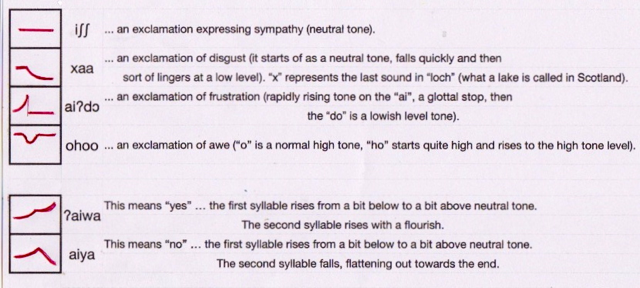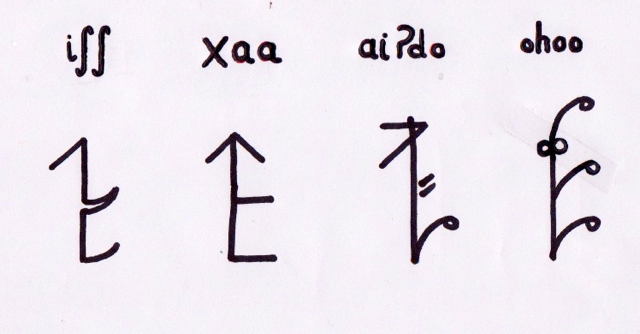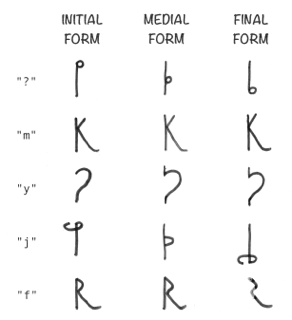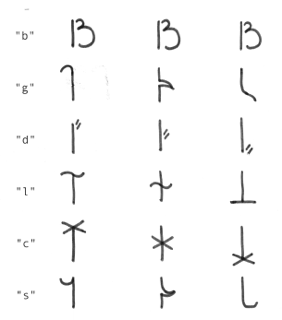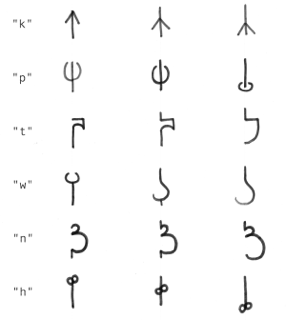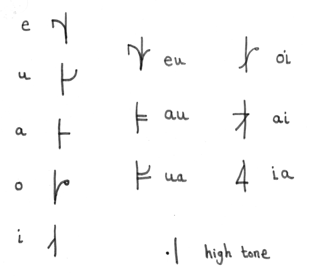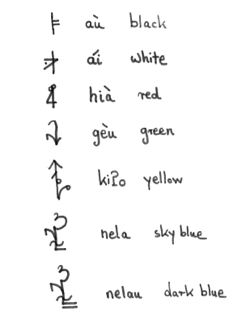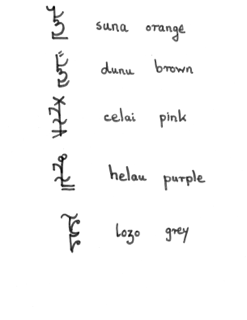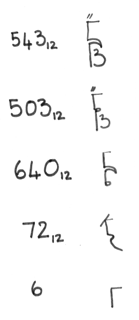Béu : Chapter 1: Difference between revisions
| Line 190: | Line 190: | ||
===Word medial=== | ===Word medial=== | ||
The following consonants and consonant clusters can be found in the middle of a word ;- | The following consonants and consonant clusters can be found in the middle of a word ;- | ||
Revision as of 17:04, 26 November 2013
..... The sounds of béu
The full range of sounds heard in béu are given below according to the conventions of the I.P.A. (International Phonetic Alphabet)
| labial | labiodental | alveolar | postalveolar | palatal | velar | glottal | |
|---|---|---|---|---|---|---|---|
| stops | p b | t d | k g | ʔ | |||
| fricatives | f | s z | ʃ ʒ | h | |||
| affricates | tʃ dʒ | ||||||
| nasals | m | n | ŋ | ||||
| liquids | r l | ||||||
| glides | w | y |
tʃ dʒ are the initial sounds of "Charlie" and "Jimmy" respectively. From now on they will be represented by c and j.
ʔ represents a glottal stop (the sound a cockney would make when he drops the "tt" in bottle). In béu this is a normal consonant ... just as real as "b" or "g" in English.
The sounds "d" and "ð" are in free variation when inside a word and between two vowels ... hence forth just referred to as d in this document.
The sounds "g" and "ɣ" are in free variation when inside a word and between two vowels ... hence forth just referred to as g in this document.
v is an allophone of f when inside a word and between vowels.
z is an allophone of s when inside a word and between two voiced* sounds.
ʃ is also an allophone of s when before the front vowel i or before the consonant y. ʃ is found in English and is usually represented by "sh" (as in "shell")
ʒ is an allophone of s when the above two conditions apply at the same time. ʒ turns up in English in one or two words. It is the middle consonant in the word "pleasure".
ŋ is an allophone of n when followed by k or g. ŋ is found in English and is usually represented by "ng" (as in "sing").
l is a clear lateral in all environments.
r is an approximant in all environments.
p, t and k are never aspirated. And on the other hand b, d and g are more voiced than in English (i.e. the voice onset time is a lot earlier)
* Actually all the phonemes are voiced, apart from p, t, k, s, f, h and ʔ.
The béu phoneme inventory is shown below.
| labial | labiodental | alveolar | postalveolar | palatal | velar | glottal | |
|---|---|---|---|---|---|---|---|
| stops | p b | t d | k g | ʔ | |||
| fricatives | f | s | h | ||||
| affricates | tʃ dʒ | ||||||
| nasals | m | n | |||||
| liquids | r l | ||||||
| glides | w | y |
The basic vowels are a, e, i, o and u. Also the diphthongs ai, au, oi, eu, ia and ua are used. Note that while the sounds ia and ua are possible sound combinations in English, they each are realised as two syllables. In béu the two components are more intertwined ... the flow into each other more. And they each represent only one syllable.
béu likes to stress the the first syllable in a word. However if the first syllable is light and the second syllable heavy, then the second syllable will receive the stress. A heavy syllable either starts with a consonant cluster (there are no syllable final clusters by the way), has a diphthong or is closed with n, s, l or r. Every syllable that isn't heavy is light.
béu differentiates between words using tone. All single syllable words have either a high tone (for example pás = "I") or a low tone (for example pà = me). All multi-syllable words lack tone (or can be said to have neutral tone). If a single syllable word, receives an affix making it into a multi-syllable word, its tone will become neutralised. If a word count was done on a typical béu text, it would be found that around 17% of words have a high tone, 33% have a low tone and 50% have the neutral tone.
Don't let the tones put you off learning béu. The chances are vanishingly small that you will cause a misunderstanding by pronouncing one of the short words wrong. And even if you speak the language and put absolutely no effort into getting the tones right ... no problem, it will just mark you out as a non-native speaker ... but who isn't :-)
In the béu writing system a small dot is placed to the right of the word if it has a high tone. If single syllable words are come across that do not have a dot .... well then you know that they must be low tone.
LINGUISTIC JARGON ... "allophone", "voiced sound" and "diphthong" are linguistic jargon. You don't have to worry if you don't understand what they mean.
..... Some interjections
All languages have a small set of interjections. Often these words fall outside the normal phonology of the language ; béu is no exception.
The bottom two words. The words for "yes" and "no" are not usually considered interjections. However I have included them here because they have distinctive tone contours (or at least they do when uttered alone).
Below is how they are written.
The first vowel sound in "ohoo" is usually not quite as long as a double length vowel, and the final vowel sound is usually a bit longer than a double length vowel.
..... Consonant clusters
Word initial
The following consonants and consonant clusters can begin a word;-
| ʔ | |||
| m | my | ||
| y | |||
| j | jw | ||
| f | fy | fl | |
| b | by | bl | bw |
| g | gl | gw | |
| d | dw | ||
| l | |||
| c | cw | ||
| s/ʃ | sl | sw | |
| k | ky | kl | kw |
| p | py | pl | |
| t | tw | ||
| w | |||
| n | ny | ||
| h |
Word medial
The following consonants and consonant clusters can be found in the middle of a word ;-
| lʔ | lm | ly | lj | lf | lb | lg | ld | lc | lz/lʒ | lk | lp | lt | lw | ln | lh | |
| ʔ | m | j | f | b | g | d | l | c | z/ʒ | k | p | t | n | h | ||
| nʔ | ny | nj | nf | mb | ŋg | nd | nc | nz/nʒ | ŋk | mp | nt | mw | nh | |||
| sʔ | zm | ʒy | zb | zg | zd | zl | sk | sp | st | zw | zn | sh |
So there are 37 initial consonants/consonant-clusters and 58 medial consonants/consonant-clusters.
Word final
The consonants n, s and r can occur word finally.
..... Plurals and duals
Plurals are NEVER uses after a number (including zero), a specifiers and FEW, MANY, etc. etc.
The normal way for single-syllable nouns to show plurality is to put the word nò in front of the noun.
nò means number (well it does when it is not qualifying another noun)
The normal way for multi-syllable nouns to show plurality is to change the final vowel of the word.
Most nouns end in one of the vowels a i u e or o.
To show plurality, these are changed to ai ia ua eu and oi respectively.
There are a few nouns (mostly body parts) that have a dual form as well as a plural form. All the word that can take a dual end in a.
The dual form is made by changing the a to au.
| wá | eye or eyes | wáu | a pair of eyes | nò wá | eyes |
| elza | ear or ears | elzau | a pair of ears | elzai | ears |
| dufa | arm/hand | dufau | a pair of arms/hands | dufai | arms/hands |
| poma | leg/foot | pomau | a pair of legs/feet | pomai | legs/feet |
| gluma | breast or breasts | glumau | a nice pair | glumai | breasts |
| jwuba | buttock or buttocks | jwubau | an arse | jwubai | buttocks |
| ploka | cheek or cheeks | plokau | cheeks | plokai | cheeks |
| olna | shoulder or shoulders | olnau | a pair of shoulders | olnai | sholders |
| kloga | shoes or shoe | klogau | a pair of shoes | klogai | shoes |
Actually when we translate, for example, "shoulders" from English into béu, nearly always the word we want is olnau. olnai is hardly ever come across.
A very small number of nouns end in ai or au. For plurality they add a (that is another syllable, a is added to the word). For example ;-
| nandau | word | nandaua | words |
| moltai | doctor | moltaia | doctors |
1 multi-syllable word is irregular ;-
glabu means "a person" and has the regular plural form glabua, however it also has a dual form ;-
glabau = a couple (not necessary married but the word gives a very strong connotation that the couple are intimate/having sexual relations)
3 single-syllable words have irregular plurals. These are ;-
| glà | woman | gala | women |
| báu | man | bawa | men |
| nò | number | nòi | numbers |
..... Thread Writing
béu has 17 consonants.
For some of these the form differs slightly, depending upon whether the letter is at word initial, word medial or word final.
The three forms are shown below.
béu has 5 vowels and 6 diphthongs.
The form of these doesn't change with their position.
These are shown below.
To give you better idea of what thread writing looks like, I have listed below the 12 colours of béu.
Nice, eh ... sort of organic
..... Numbers
béu uses base 12.
| one = | aja | 1012 = | ajau | 10012 = | ajai |
| two = | aufa | 2012 = | ufau | 20012 = | ufai |
| three = | aiba | 3012 = | ibau | 30012 = | ibai |
| four = | uga | 4012 = | ugau | 40012 = | agai |
| five = | ida | 5012 = | idau | 50012 = | idai |
| six = | ela | 6012 = | ulau | 60012 = | ulai |
| seven = | oica | 7012 = | icau | 70012 = | icai |
| eight = | eza | 8012 = | ezau | 80012 = | ezai |
| nine = | oka | 9012 = | okau | 90012 = | okai |
| ten = | iapa | 10x12 = | apau | 10x12x12 = | apai |
| eleven = | uata | ............. 11x12 = | atau | ............. 11x12x12 = | atai |
You will noticed that 12 numbers over eleven have been shortened. For example the "regular" form for 20 would be aufau, but this is actually ufau.
Also the number 6, ela has been shortened. This would have been eula if everything was perfectly regular.
In the above table, 10 is actually, of course 12 : 90 is (9x12)+0 => 108 etc. etc.
The numbers in the above table combine, to express every number from 1 -> 1727 in one word. For example ;-
| 54312 | idaigauba |
| 50312 | idaiba |
| 64012 | ulaigau |
| 7212 | icaufa |
| 612 | ela |
The above explains about the pronunciation of the numbers. But how are they written.
In fact the numbers are NEVER written out in full. See below for the characters corresponding to the five numbers above.
It can be seen that all the vowels are dropped and there is a horizontal line inserted in the top right of the character. The symbol for h is used for inserting zeroes (although never pronounced).
If you had a leading zero you would use the word jù which is usually placed before nouns and means "space/empty/zero/no". 007 would be jù jù oica (three words)
To deal with a telephone number, you would lump the numbers in threes (any leading zero or zeroes by themselves though) and outspeak the numbers. If you were left with a single digit (say 4) it would be pronounced agai. If you were to pronounce it uga, it would of course mean 004. Also you would probably add the particle dó at the end. This means "exactly" (or it can mean the speaker has finished outspeaking the number)
Ordinal numbers
To get an ordinal number you just attach n- to the front of the cardinal number. So we have ;-
| first | naja |
| second | naufa |
| third | naiba |
| fourth | nida |
| etc. | etc. |
May be this form originally came from an amalgamation of nò plus the number.
These forms are adjectives 100% and are always written out in full.
Fractional numbers
To get an fractional number you just attach d- to the front of the cardinal number. So we have ;-
| a unit | daja |
| a half | daufa |
| a third | daiba |
| a quarter | dida |
| etc. | etc. |
May be this form originally came from an amalgamation of ??? plus the number.
These are fully numbers. They are written in the same way as numbers, except the have a squiggle above them. The squiggle looks like an "8" on its side that hasn't fully closed.
And so ends chapter 1 ...
..... Index
- Introduction to Béu
- Béu : Chapter 1 : The Sounds
- Béu : Chapter 2 : The Noun
- Béu : Chapter 3 : The Verb
- Béu : Chapter 4 : Adjective
- Béu : Chapter 5 : Questions
- Béu : Chapter 6 : Derivations
- Béu : Chapter 7 : Way of Life 1
- Béu : Chapter 8 : Way of life 2
- Béu : Chapter 9 : Word Building
- Béu : Chapter 10 : Gerund Phrase
- Béu : Discarded Stuff
- A statistical explanation for the counter-factual/past-tense conflation in conditional sentences
